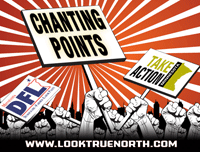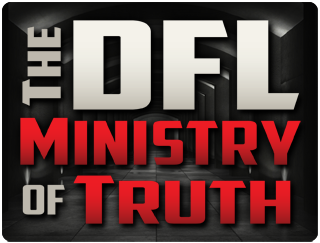Governor Dayton will give the official State of the State address tomorrrow.
I figured I’d grab a jump on him, and – in my constitutional position as a freaking taxpayer – give the real state of this state.
You’re welcome.
Now – all rise.
———-
My fellow Minnesotans,
Thanks to eight years of responsible Republican – and conservative-enough – governorship, the state of Minnesota is doing…OK. Unemployment is well below the national average. Our schools, on a state-wide basis, don’t suck as bad as those in some other states. As any good Scandinavian would put it, “we could be doing worse”.
But there is so much room for improvement.
Oh – you may be seated. Sorry.
A good chunk of Minnesota’s establishment – government, educational, union and media – is stuck in the 1970’s. It was an era when America had no economic competition – Germany and Japan were just starting to find their legs after World War II; China was still a Maoist dystopia; academic experts like Paul Ehrlich thought that India would be so wracked by starvation that it would always be what Somalia is today.
And in that environment, everyone got spoiled and fat. The unions got used to demanding and getting pay and benefits around the country that were easy to support – provided we had no competition. And American government, after three decades of aiming toward cradle-to-grave welfare, finally achieved it.
We did the same here in Minnesota. Our business climate settled to favor big businesses, the kind that “partner” with big government the way that remora fish “partner” with sharks. Our welfare state turned our cities into warehouses for the poor – an endless homework project for the state’s social service system, for which they’re always taking a grade of “incomplete”, claiming “the dog ate my homework”.
That, unfortunately, is exactly where one of our major parties, the DFL, is stuck. They have not had a new idea since 1974. Their entire worldview is centered around the idea “if we pretend it’s still 1978, maybe it’ll all be OK!”.
Minnesotans took a huge step toward reality in 2010. We elected two chambers full of people who know that times have changed, and we have to stay ahead of the changes in the world around us, rather than just ignore them.
Oh, 8,000 Minnesotans who should have known better believed what the Alliance For A Better Minnesota told them rather than their own lying eyes. And that’s being charitable; if I were a betting man, I’d say that if you left out all the ineligible voters, repeat voters and felons, it would have been Mark Dayton looking at an 8,000 vote deficit. But that’s just a hunch.
So today we have a split government; a legislature with a powerful mandate, dividing power with a weak governor whose own party basically treats him like a coffee enema; he did beat their endorsed candidate, after all.
And so the DFL does what it always does when it’s up against the ropes; it lies. The Alliance For A Better Minnesota – essentially a PR agency for what the “Occupy” movement, if you remember them, call “The One Percent” – has basically taken over the DFL. And you can tell they’re lying when you see their fingers moving over keyboards, or whenever you see Denise Cardinal or Carrie Lucking on the TV.
And have any of you actually seen Denise Cardinal or Carrie Lucking in the same place?
And the media does what it always does when the DFL is up against the ropes; its editorialists declaim endlessly on the virtue of compromise.
My fellow Minnesotans, in response I say two things.
Number one? Doy. Compromise is part and parcel of politics. But it’s something you do after you have the debate. And when you debate, you bring the strengths of your own case, and explore and exploit the weaknesses in your enemy’s case. And you do your best to work the compromise in your favor – meaning, obviously, in favor of the agenda for which you were sent to office. In other words, compromise is a negotiationl. And negotiations are always best made from a position of strength.
And so the GOP must use our strength – numbers, evolving demographics, mindshare – to make sure the “compromise” we get reflects the fact that we won.
And number two? Bull pucks. We won. And we’re going to legislate like we won – like a a party with a vision for a much much better Minnesota – a Minnesota that’s not dependent on state handouts, a Minnesota that works and prospers. A Minnesota that keeps Big Brother’s passive-aggressive benevolence in its place – there to take care of its allotted business, and there for emergencies, doing its mandated job. And no more.
So what do we do this session?
The agenda is simple.
First – pass Reform 2.0. Make government more user-friendly, especially for business. Our permitting process is a sham.
Second – pass Zero Based Budgeting. Our current cost-plus budgeting not only guarantees that we will soon not be able to afford our government, it also puts the our government – our “servant” – in a position of being in arrogant, hectoring control of the whole state; of saying “you, the peasants, serve us first, and yourselves last”. We need to flip that around.
Third – No budget increase. We’re at 35 Billion. That is plenty. Not one dime more. Not even if the revenue forecast rises. Minnesotans are working hard – and if the economy grows, the temptation is there to turn that into more revenue for government spending. No. Bullshit. Rebate all surpluses. And not via the DFL’s convoluted targeted rebates; rebate them in exact proportion of state income taxes paid. If you pay in, you get back. If you don’t, then you already got lucky once; give someone else their turn.
Fourth – Reform our voting system. It’s not just Voter ID – although that’d be a great start. Abolishing vouching would also be a great next step. Isn’t the franchise – for which so many hundreds of thousands of our ancestors fought and died – and the integrity of the election system that determines who runs our democracy, worth a tiny little bit of administrative conscientiousness on the part of someone claiming to be a “citizen” today?
Yes. Yes, it is.
Fifth – Pass Representative Cornish’s Stand Your Ground bill. I put it in my State of the State address for a reason; it’s not that it’s necessarily the fifth most important bill on the entire raft of legislation facing this state. But symbolically, it’s a vital priority. After reforming our government and our budgeting process and holding the line on spending, letting government know, once and forever, that we the people are sovereign, and that our right to defend our lives and families supersedes both criminals’ peace of mind and prosecutors’ convenience, is vital. Criminals should be afraid to go out at night – not we, the people. And it’ll be a lovely thumb in the eye of the Metrocrats. They deserve it.
Sixth – get the Met Council out of the rail baron and utopia-planning businesses. In a metro with cheap land and horizontal sprawl, light rail makes no, zero, nada sense. And forcing people into high-density developments to justify those rail lines is downright stupid – not just a waste of money, but a vile overreach on the part of government.
In Mitch Berg’s Minnesota, the government is the servant, not the master – and we, the people, continually affirm it. Just like training a dog; if we, the people, give the government constant, consistent discipline, it might just learn its place and be useful enough not to put down.
Although government, like any dog, must know that if it craps on our carpet again, it’s going in the car for that drive “out to the country”.
In Mitch Berg’s Minnesota, government scrimps and saves, and the people keep most of what they work for. We have the government we need, not the government the governing class wants.
In Mitch Berg’s Minnesota, the people work out a compromise with government from a position of strength, and the government knows its place.
And that’s the state of the State of Minnesota. It could be worse. It should be much better. And only Mark Dayton and his one-percenter minions stand in the way.
So to sum up the whole address; let’s show this state who’s boss.
Thank you. God Bless Minnesota, and God Bless America.







